Cat5e and Cat6 cables differ primarily in speed and bandwidth capabilities, with Cat6 supporting up to 10 Gbps over shorter distances and Cat5e typically capping at 1 Gbps. Cat6 cables feature tighter twists and often include a separator to reduce crosstalk, enhancing overall performance in high-interference environments. Choosing Cat6 future-proofs network setups by accommodating faster data transfer and improved signal quality, especially critical for demanding applications and larger networks.
Table of Comparison
| Feature | Cat5e | Cat6 |
|---|---|---|
| Maximum Speed | 1 Gbps | 10 Gbps |
| Maximum Frequency | 100 MHz | 250 MHz |
| Maximum Cable Length for Speed | 100 meters at 1 Gbps | 55 meters at 10 Gbps |
| Cable Construction | Unshielded Twisted Pair (UTP) | Usually Shielded Twisted Pair (STP) or UTP |
| Use Case | Home networks, basic office setups | High-speed networks, data centers, professional environments |
| Backward Compatibility | Yes, supports older standards | Backward compatible with Cat5e and Cat5 |
| Cost | Lower cost | Higher cost |
Introduction to Cat5e and Cat6 Cables
Cat5e cables support up to 1 Gbps speeds over 100 meters and are widely used for residential and small business Ethernet connections. Cat6 cables offer higher performance, supporting 10 Gbps speeds over shorter distances (up to 55 meters) with improved insulation to reduce crosstalk. Both cables use twisted-pair technology but differ in thickness, shielding, and bandwidth capacity, impacting network speed and reliability.
Key Differences Between Cat5e and Cat6
Cat6 cables offer higher performance with a bandwidth of up to 250 MHz compared to Cat5e's 100 MHz, enabling faster data transfer speeds up to 10 Gbps over shorter distances. Cat6 features stricter specifications for crosstalk and system noise, resulting in improved signal quality and reduced interference. The enhanced insulation and thicker gauge in Cat6 cables provide better durability and support for more demanding network environments than Cat5e.
Speed and Bandwidth Capabilities
Cat6 cables support higher speeds up to 10 Gbps over shorter distances of 55 meters compared to Cat5e's 1 Gbps over 100 meters. Cat6 also offers improved bandwidth capabilities, delivering up to 250 MHz, while Cat5e supports a maximum of 100 MHz. This makes Cat6 more suitable for demanding network environments requiring faster data transmission and reduced crosstalk.
Performance in Real-World Scenarios
Cat6 cables offer significantly better performance in real-world networking scenarios, supporting bandwidths up to 250 MHz compared to Cat5e's 100 MHz, which results in faster data transmission and reduced crosstalk. Cat6 supports Gigabit Ethernet and 10 Gigabit Ethernet at shorter distances, making it ideal for high-demand applications like streaming, gaming, and large file transfers. In contrast, Cat5e remains sufficient for most home and small office environments but may experience limitations in speed and interference in dense network setups.
Shielding and Interference Protection
Cat6 cables typically feature improved shielding options compared to Cat5e, including both Unshielded Twisted Pair (UTP) and Shielded Twisted Pair (STP) variants, enhancing protection against electromagnetic interference (EMI). Cat5e mostly relies on UTP design, which offers basic interference resistance suitable for standard networking environments but is less effective in high-interference settings. Shielding in Cat6 reduces crosstalk and external noise, supporting higher data rates and more reliable signal transmission, especially in industrial or densely cabled installations.
Use Cases and Application Environments
Cat5e cables are ideal for home networking and small office setups requiring speeds up to 1 Gbps over distances up to 100 meters, making them suitable for internet browsing, streaming, and VoIP applications. Cat6 cables support higher bandwidths and speeds up to 10 Gbps at shorter distances (up to 55 meters), fitting environments like data centers, enterprise networks, and advanced gaming or multimedia setups that demand reduced crosstalk and improved signal quality. Choosing between Cat5e and Cat6 depends on future-proofing needs, network speed requirements, and the physical layout of the installation space.
Installation Considerations and Requirements
Cat6 cables require more precise installation techniques than Cat5e due to their higher performance standards and stricter adherence to bend radius and separation from interference sources. Installing Cat6 often demands quality connectors and keystone jacks specifically rated for Cat6, ensuring optimal signal integrity over longer distances compared to Cat5e. Proper testing tools are essential for verifying Cat6 compliance, as poor installation can negate the cable's enhanced capabilities, unlike the more forgiving Cat5e installation process.
Cost Comparison: Cat5e vs Cat6
Cat5e cables typically cost between $0.20 to $0.50 per foot, making them a budget-friendly choice for standard networking needs. Cat6 cables, priced around $0.40 to $1.00 per foot, offer higher performance and support for faster data rates but come at a higher cost. The investment in Cat6 cabling can be justified by its enhanced capability to handle Gigabit and 10 Gigabit Ethernet, providing better future-proofing despite the initial expense.
Future-Proofing Your Network
Cat6 cables offer higher bandwidth capacity, supporting up to 10 Gbps speeds over 55 meters, compared to Cat5e's maximum of 1 Gbps, making Cat6 a better choice for future-proofing your network. Enhanced shielding in Cat6 reduces crosstalk and electromagnetic interference, ensuring more reliable and faster data transmission as network demands increase. Investing in Cat6 infrastructure prepares your network for upcoming technologies and higher data rates, extending longevity and performance efficiency.
Choosing the Right Cable for Your Needs
Cat5e cables support speeds up to 1 Gbps and are ideal for standard home networks or small offices with moderate data demands. Cat6 cables offer higher performance with speeds up to 10 Gbps over shorter distances, making them suitable for environments requiring faster data transfer and reduced crosstalk. Selecting between Cat5e and Cat6 depends on your network speed requirements, distance, and budget considerations.
Cat5e vs Cat6 Infographic

 techiny.com
techiny.com